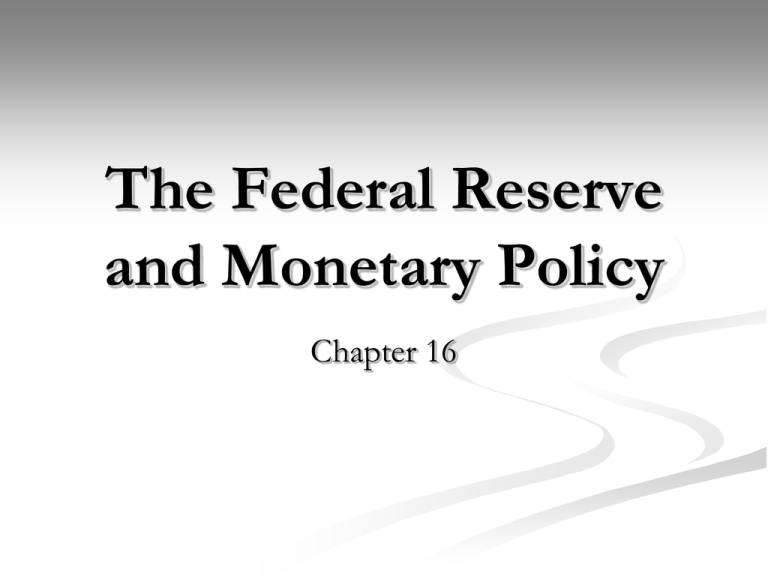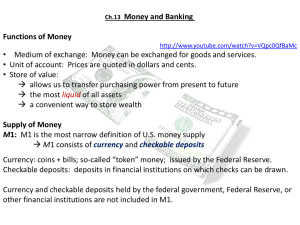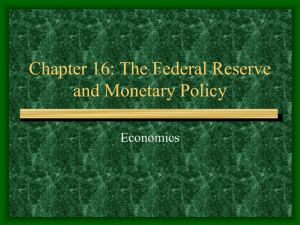The Federal Reserve and Monetary Policy
advertisement

The Federal Reserve and Monetary Policy Chapter 16 The Federal Reserve System Chapter 16, Section 1 Federal Reserve Act of 1913 Created the Federal Reserve (FED) System of federal banks 12 districts Overseen by the Board of Governors 7 governors 14 year terms appointed by the President Appoints a chair confirmed by the Senate Chairs serve a four year term that can be renewed FED Districts 12 districts District bank reports on economic activity in the district to the central bank Member banks... All nationally chartered banks are required to join the Fed. Member banks contribute funds to join the system, and receive stock in and dividends from the system in return. This ownership of the system by banks, not government, gives the Fed a high degree of political independence. The FOMC (Federal Open Market Committee), which consists of The Board of Governors and 5 of the 12 district bank presidents, makes key decisions about interest rates and the growth of the United States money supply. 4,000 member banks and 25,000 other depository institutions Board of Governors Federal Open Market Committee 12 District Reserve Banks Structure of the Federal Reserve System Federal Reserve Functions Chapter 16, Section 2 Functions of the FED Banking and fiscal services to the government Banking and fiscal services to member and nonmember banks Regulates the banking industry Tracks and manages the money supply Serving the Government Acts as the Government’s bank Maintains a checking account for the treasury Sells securities Issues currency Coins are created at the US Mint Currency is created by the Bureau of Engraving and Printing The FED issues the currency Serving Banks Check clearing Loans to member banks Stock to member banks Supervise lending practices Lender of last resort Banks loan money to each other and charge interest known as the Federal Funds Rate The FED can lend funds to banks in times of need and charge interest This is called the discount rate Regulating the Banking System The FED requires banks to report on their reserves Examine banks to ensure they are following regulations Examiners look at the banks Net Worth to determine if they are in trouble Net Worth represents total assets minus total liabilities Regulating the Money Supply FED is best known for regulating the money supply Factors that affect demand for money Cash needed on hand Interest rates Price levels in the economy General level of income The laws of supply and demand work the same with the money supply Monetary Policy Tools Chapter 16, Section 3 Monetary Policy Monetary policy refers to the action the FED takes to influence economic performance The FED can use monetary policy in a number of ways Money creation...not making it but putting it into circulation Changing reserve requirements Changing the discount (interest) rates Purchasing bonds Money Creation Banks keep a certain amount of funds on hand The required reserve ratio (RRR) is the amount that must be kept by banks...this is established by the FED After the RRR is kept, banks can loan money. This process, along with gained interest creates money...or adds it to the money supply The money multiplier formula tells us how much money will be created through this process However, banks may keep excess reserves on hand More money than is required by the RRR Reserve Requirements The FED can influence the economy by changing the RRR Raising the RRR will reduce the money in circulation Lowering it will increase the money in circulation FED does not do this today as it can be very disruptive to the loan process Loans may have to be recalled The Discount Rate Banks borrow from the FED and the interest charged is known as the discount rate. In turn, these banks loan to customers (you and me) and the interest rate charged is known as the prime rate. By changing the discount rate, the prime rate changes and affects our spending behaviors Raising the discount rate will slow borrowing, spending and the economy Lowering the discount rate will increase borrowing, spending, and increase the economy 2nd most used form of Monetary Policy Open Market Operations The most used monetary tool is open market operations The FED can purchase bonds to put money into circulation They sell government bonds to take money out of circulation Review 1. The required reserve ratio is (a) the ratio of deposits to reserves required of banks by the Federal Reserve. (b) the ratio of accounts to customers required of banks by the Federal Reserve . (c) the ratio of reserves to deposits required of banks by the Federal Reserve. (d) the ratio of paper currency to coins required of banks by the Federal Reserve. 2. All of the following will increase the money supply except (a) increasing the required reserve ratio. (b) bond purchases by the Fed. (c) reducing the required reserve ratio. (d) reducing the discount rate. Monetary Policy and Macroeconomic Stabilization Chapter 16, Section 4 Using Monetary Policy Monetarism...the belief that the money supply is the most important factor in macroeconomic performance Money supply and interest rates In basic terms, the interest rate is the cost of money Works under the principles of supply and demand When money supply is high, interest rates are low When money supply is low, interest rates are high Easy Money vs. Tight Money Policy When money is in low supply, the FED may follow an easy money policy...or follow policy that will increase the money supply When money is in high supply, the FED will try to lower the money supply or use tight money policy Timing of Monetary Policy Policies of Monetary Policy need to be carefully enacted to have the desired effect...if they are not time accordingly, they may have a negative effect on the business cycle Like with Fiscal Policy, Monetary Policy takes time to put in place and take effect...lags Inside lag... Delay in implementing monetary policy The government takes time to recognize the problem and create a solution Outside lag...the time it takes for the policy to have an effect Predictions of the business cycle is key in this process Fiscal and Monetary Policy Tools Fiscal and Monetary Policy Tools Fiscal policy tools Expansionary Tools Contractionary Tools 1. Increase government spending 2. Cutting taxes 1. Decrease government spending 2. Raising taxes Monetary policy tools 1. Open market operations: bond purchases 2. Decreasing the discount rate 3. Decreasing reserve requirements 1. Open market sales: bond sales 2. Increasing the discount rate 3. Increasing reserve requirements Remember Fiscal Policy is how the government uses its taxing and spending to influence the economy Monetary Policy is how the FED uses its control of the money supply to influence the economy Review 1. Monetarism is (a) the time it takes to enact monetary policy. (b) the belief that the money supply means little to macroeconomic performance. (c) the time it takes for monetary policy to take affect. (d) the belief that the money supply is the most important factor in macroeconomic performance. 2. Tight money policies aim to (a) increase the money supply and expand the economy. (b) decrease the money supply and expand the economy. (c) decrease the money supply and slow the economy. (d) increase the money supply and slow the economy.









